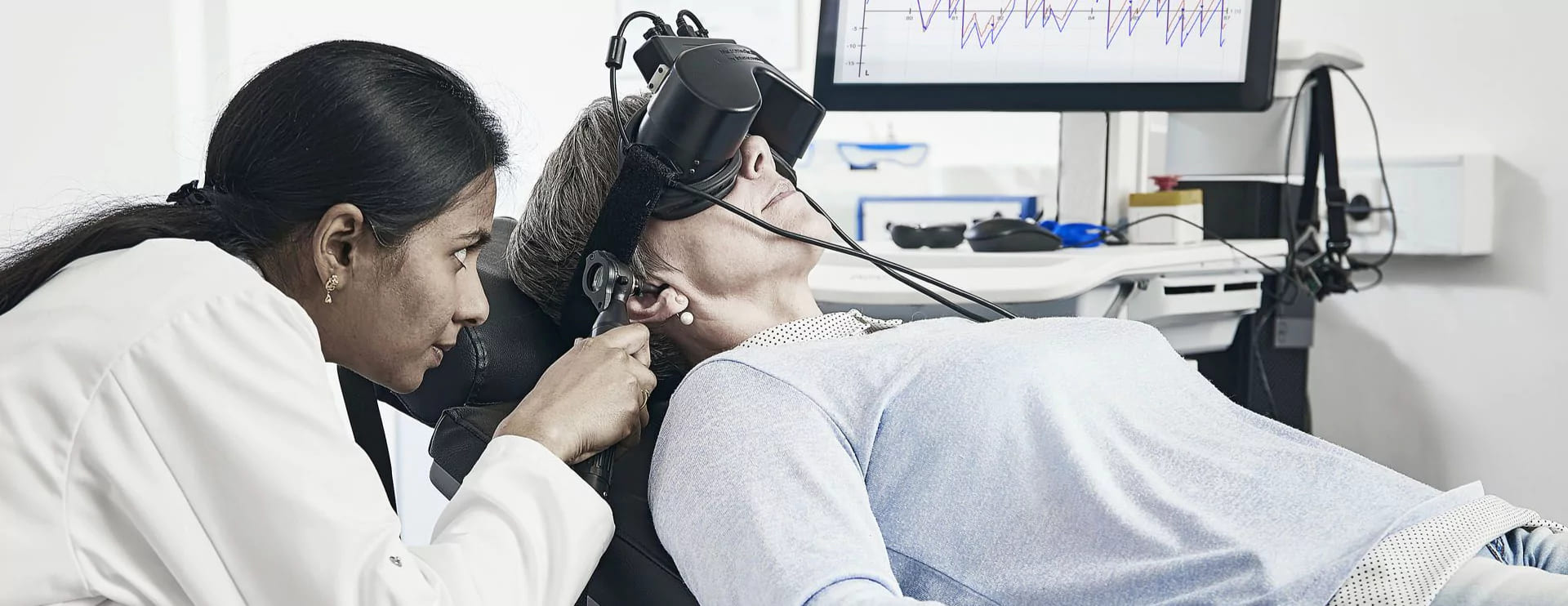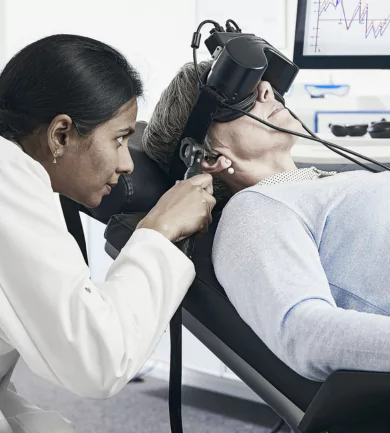

Videonystagmography
Videonystagmography is an examination that analyses nystagmus, using a video camera coupled with a computer to analyse eye movements.
Nystagmus is a movement of the eyes following a movement of the head or body, in the plane of this movement (vertical, horizontal, rotational or torsional), with a slow deviation of the eyes at the same speed and in the opposite direction to that of the head, in order to maintain stable vision during the movement, and a rapid return saccade in the opposite direction when maximum eye deviation is reached.
Nystagmus is a normal stabilisation process of gaze during movement. In the absence of movement, nystagmus is always pathological. Nystagmus can be found in the case of damage to the balance sensors of the inner ear (semicircular canals, otolithic sensors), the vestibular nerve or the central nervous system (particularly the brainstem).
Video nystagmography is the cornerstone of the study of the balance system.


Videonystagmography procedure
Videonystagmography involves several steps that provide additional information:
The search for spontaneous nystagmus. Its presence is always pathological.
The search for nystagmus when shaking the head (the ear is stimulated at a frequency of 2 Hz), in order to look for asymmetries in vestibular function and possible signs of altered central balance.
The search for nystagmus in lateral and vertical gaze may indicate a disturbance in central balance.
Vibration-induced nystagmus, which tests vestibular function at high frequencies, outside the vestibular operating range. Its value lies in the fact that even a long-standing deficit is never compensated for in this frequency range and can therefore be detected even if compensation has been established. This examination is also interesting in the search for a “third window” in the inner ear, as in dehiscence of the superior semicircular canal (MINOR syndrome).
The search for positional nystagmus is an essential part of the examination. If this positional nystagmus is accompanied by vertigo, we speak of positional vertigo. The most common is benign paroxysmal positional vertigo, but it can also be found in central vestibular disorders.
Rotatory tests in which the vestibule is tested with its physiological stimulus, i.e. in motion (rotation on a chair in the horizontal plane) in a low frequency range from 0.01 to 0.064 Hz. The aim is to measure the gain (efficiency) of the vestibular system in the horizontal plane and look for a decrease in overall gain or asymmetry between the two vestibules. The disadvantage is that the two ears cannot be analysed separately, as the horizontal canals of both ears, located in the same plane, are stimulated simultaneously.
Caloric tests, on the other hand, stimulate each ear separately. They mainly examine the horizontal canals. Each ear is stimulated successively with cold water (7° below body temperature) and then with warm water (7° above body temperature). These are used to assess the overall reflectivity of the vestibular system (sum of the reflectivity of the two ears) and to compare the two ears to each other. They assess vestibular responses at very low frequencies, between 0.003 Hz and 0.04 Hz.
Separate assessment of the three canals in each ear can only be performed with the VHIT or Video Head Impulse Test.
Videonystagmography is therefore an essential part of the assessment of vertigo or balance disorders. In order for it to provide relevant information, it must be performed in a rigorous manner. It must be part of a diagnostic approach that includes careful and thorough questioning, a clinical examination of the vestibular apparatus and the neurological system and, if necessary, other investigations:
- Objective and/or subjective audiometric tests.
- Otolithic evoked potentials (PEO or ocular and cervical VEMP)
- VHIT or Video Head Impulse Test.
- Dynamic visual acuity, subjective visual acuity, search for abnormal visual dependency or abnormal sensitivity to optical flows.
- Stabilometry.
OTONEURO MONACO is a reference centre for the evaluation of vertigo and balance disorders, collaborating with leading medical research institutes (CNRS, GDRV, INSERM). All these investigations are performed by highly qualified staff using the best equipment available on the market.
